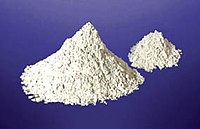Aluminium nitride
 |
|
 |
|
| Names | |
|---|---|
| Other names
Aluminium nitride
|
|
| Identifiers | |
|
24304-00-5 |
|
| 3D model (Jmol) | Interactive image |
| ChEBI |
CHEBI:50884 |
| ChemSpider |
81668 |
| ECHA InfoCard | 100.041.931 |
| EC Number | 246-140-8 |
| PubChem | 90455 |
| RTECS number | BD1055000 |
|
|
|
|
| Properties | |
| AlN | |
| Molar mass | 40.9882 g/mol |
| Appearance | white to pale-yellow solid |
| Density | 3.260 g/cm3 |
| Melting point | 2,200 °C (3,990 °F; 2,470 K) |
| Boiling point | 2,517 °C (4,563 °F; 2,790 K) decomposes |
| hydrolyses (powder), insoluble (monocrystalline) | |
| Solubility | insoluble, subject of hydrolysis in water solutions of bases and acids |
| Band gap | 6.015 eV (direct) |
| Electron mobility | ~300 cm2/(V·s) |
| Thermal conductivity | 285 W/(m·K) |
|
Refractive index (nD)
|
1.9–2.2 |
| Structure | |
| Wurtzite | |
| C6v4-P63mc | |
| Tetrahedral | |
| Thermochemistry | |
| 30.1 J/mol K | |
|
Std molar
entropy (S |
20.2 J/mol K |
|
Std enthalpy of
formation (ΔfH |
318 kJ/mol |
|
Gibbs free energy (ΔfG˚)
|
287.4 kJ/mol |
| Hazards | |
| NFPA 704 | |
|
Except where otherwise noted, data are given for materials in their standard state (at 25 °C [77 °F], 100 kPa).
|
|
|
|
|
| Infobox references | |
Aluminium nitride (AlN) is a nitride of aluminium. Its wurtzite phase (w-AlN) is a wide band gap (6.01-6.05 eV at room temperature) semiconductor material, giving it potential application for deep ultraviolet optoelectronics.
AlN was first synthesized in 1877, but it was not until the middle of the 1980s that its potential for application in microelectronics was realized due to its relatively high thermal conductivity for an electrically insulating ceramic (70–210 W·m−1·K−1 for polycrystalline material, and as high as 285 W·m−1·K−1 for single crystals).
Aluminium nitride is stable at high temperatures in inert atmospheres and melts at 2800 °C. In a vacuum, AlN decomposes at ~1800 °C. In the air, surface oxidation occurs above 700 °C, and even at room temperature, surface oxide layers of 5-10 nm have been detected. This oxide layer protects the material up to 1370 °C. Above this temperature bulk oxidation occurs. Aluminium nitride is stable in hydrogen and carbon dioxide atmospheres up to 980 °C.
The material dissolves slowly in mineral acids through grain boundary attack, and in strong alkalies through attack on the aluminium nitride grains. The material hydrolyzes slowly in water. Aluminium nitride is resistant to attack from most molten salts, including chlorides and cryolite.
AlN is synthesized by the carbothermal reduction of aluminium oxide in the presence of gaseous nitrogen or ammonia or by direct nitridation of aluminium. The use of sintering aids, such as Y2O3 or CaO, and hot pressing is required to produce a dense technical grade material.
...
Wikipedia

